A projection system capable of taking and projecting a widescreen image with a 180-degree field of view, from a single strip of 35mm film, developed by Rowe E. Carney, Jr. and Tom F. Smith from Rolla, MO, United States.
Film Explorer
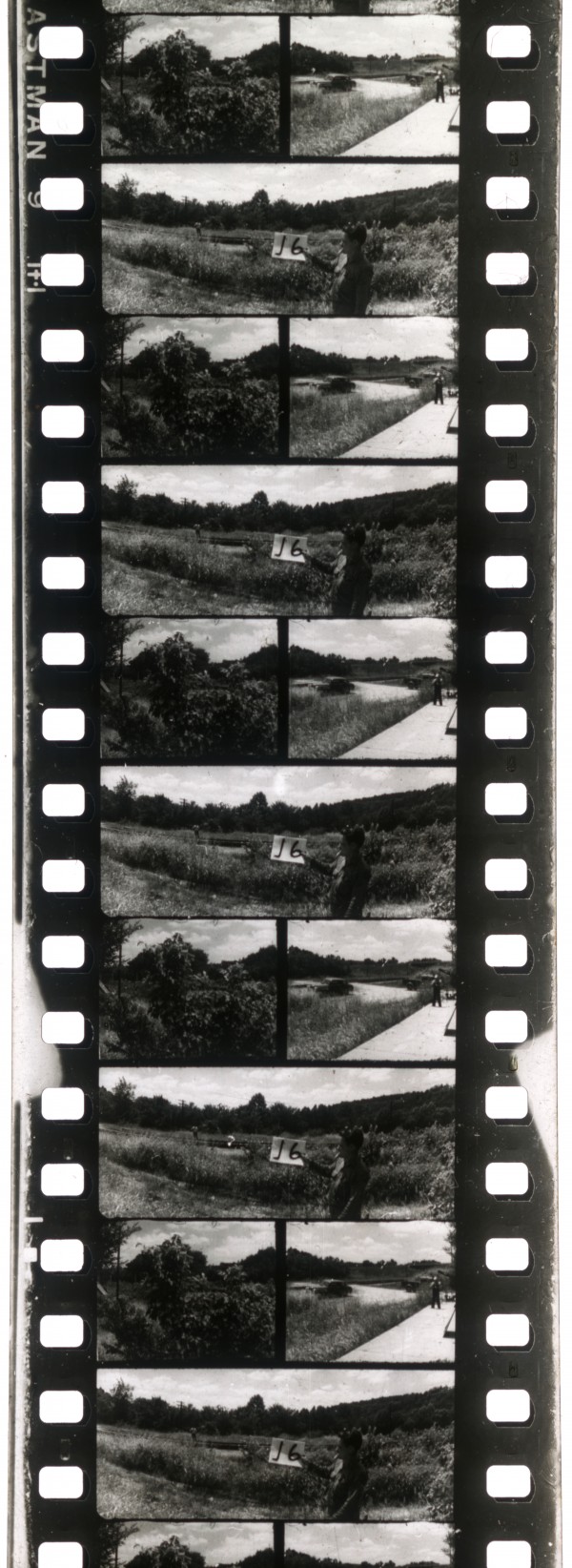
A 35mm Rotoscope test, entitled Practice pans near Arlington, Missouri (c. 1959).
Rotoscope Collection (R1499), The State Historical Society of Missouri, Rolla, MO, United States.

35mm Rotoscope film strip showing a scene from a steam engine show, in 1961. A 180-degree panoramic image was divided into two side-by-side images, with each encompassing a 45-degree view, and another at the bottom that spanned 90 degrees. The resulting composite image, made up of these three elements, was projected onto an extra-wide, curved screen.
Rotoscope Collection (R1499), The State Historical Society of Missouri, Rolla, MO, United States.
Identification
Unknown
Approx.
B/W or color.
Standard Eastman Kodak edge markings.
1
Some tests were shot using Eastmancolor film.
Unknown
Silent or variable-density optical track.
An extra-wide image was divided into three sections photographed within a frame area measuring 20.32mm x 19.30mm (0.800 in x 0.760 in). This frame was split into two sections at the top measuring 10.16mm x 9.65mm (0.400 in x 0.380 in) and one section below these measuring 20.32mm x 9.65mm (0.800 in x 0.380 in).
B/W or color.
Unknown
History
The Rotoscope film technology, originally the Smith-Carney System, was a camera and projector-attachment system that allowed for the filming and projection of a 180-degree view, using a single reel of 35mm film. The work of inventors Rowe Carney, Jr. and Tom Smith, the invention drew attention to Rolla, Missouri in the 1960s, but did not have a wide impact.
Rowe Carney, Jr. was born in 1924 in Rolla, Missouri. Carney’s father was a self-made millionaire, and part of that wealth included ownership of several movie theaters in Rolla, St. James and Lebanon, Missouri. Rowe grew up in and around the theaters, and later took over management of several of his fathers’ businesses, including the movie theaters. Rowe also worked as a film projectionist during his service in World War II (Carney, 2018).
Tom Fields Smith was born in 1914 in Kansas City, Kansas. He began his work in theaters in Humansville, Missouri where he worked as a projectionist. A natural engineer with a gift for tinkering with the projector systems used by movie theaters, he debuted his ‘multiscope’ drive-in theatre design in 1953, in Urbana, Missouri, with a 55-car capacity. A year later he began construction of the Buffalo Autoscope Theatre north of Buffalo, Missouri on Highway 65 (The Index, 1954). Consisting of a single projector, the design boasted multiple screens arranged in a circle around the projector. Each car would have its own screen, with the film being back projected – the setup could serve about 122 cars at a time. Smith would go on to design and build another larger Autoscope theater in Albuquerque, New Mexico (Looney, 1963: p. B2).
Carney, at that time the manager of the family’s theaters in central Missouri, sought to keep up with current cinematographic developments and traveled to New York City in 1952. There he was inspired by This Is Cinerama. Though Carney was impressed by the Cinerama film technology – which used three strips of film projected in synchronization to create an extra-wide image on a curved screen – he realized that the process was expensive and inefficient. He became convinced that he could create a similar film experience that was cheaper to produce and avoided the need for multiple projectors, and eliminated (or, at least, greatly reduced) any gaps between the composite sections. Returning to Rolla, Carney brought on Smith to help him run tests and experiments. The two worked together to create a system of lenses, mirrors and other equipment that could capture a 180-degree view and then project it seamlessly from one reel of 35mm film onto a specially designed curved screen.
Carney purchased a Mitchell NC 35mm camera from his father in 1953, which, along with spare projection parts foraged from the family’s theaters, the pair were able to use to begin researching and experimenting in 1954, and were shooting test shots by 1959. They tried out various types of lenses, focal lengths and angles of the camera attachment, B/W versus color film, and moving the camera versus a stationary tripod. They worked on different ways to add movement to enhance the immersive effect. Their test scenes included shots in front of the Uptown Theatre in Rolla, a roller coaster ride in St. Louis and aerial views from a plane ride over Vichy, MO. Carney also attached a camera to the hood of his car and filmed scenes in Rolla, Phelps County, St. Louis and Jefferson City.
Each test reel had to be sent to Kodak to be developed, delaying the process as they waited to see the outcome of each test before making adjustments to any mirrors or lenses. To cut costs they initially shot only negatives. If any reels were deemed worthy, they were sent back to the lab for a print copy to be made. The pair took clips from each of their most successful tests splicing them together for a demonstration reel, to which they added a separate, synchronized soundtrack, voiced by KCLU radio station owner, Roy Stanley (Carney, 2018).
In 1957 the pair applied for patents on a textured curved screen, camera and projector attachments. The applications were approved by the US Patent Office in 1962, and patents were later granted by Japan, Germany, Great Britain, Canada, Mexico, France and Italy. A demonstration film was shown to industry insiders, on a few occasions in late 1958 and early 1959. The Rotoscope demo film was first shown publicly in May 1961, at the Rollamo Theatre in Rolla, Missouri, and then at the Rowe Theater in St. James, Missouri. Newspapers and critics from the time judged the technology fantastic and sensational. Despite the industry’s initial curiosity and the local public interest, Carney and Smith were unable to convince film companies to adopt the technology. As a result, the Rotoscope never caught on, outside of Phelps County.
Selected Filmography
One of 44 test reels shot by Carney and Smith. An unpreserved 35mm copy survives in the Rotoscope Collection at the State Historical Society of Missouri.
One of 44 test reels shot by Carney and Smith. An unpreserved 35mm copy survives in the Rotoscope Collection at the State Historical Society of Missouri.
One of 44 test reels shot by Carney and Smith. An unpreserved 35mm copy survives in the Rotoscope Collection at the State Historical Society of Missouri.
One of 44 test reels shot by Carney and Smith. An unpreserved 35mm copy survives in the Rotoscope Collection at the State Historical Society of Missouri.
Footage of Rolla, MO; St. Louis, MO; Jefferson City, MO; and the Mississippi River. An unpreserved 35mm copy survives in the Rotoscope Collection at the State Historical Society of Missouri.
Footage of Rolla, MO; St. Louis, MO; Jefferson City, MO; and the Mississippi River. An unpreserved 35mm copy survives in the Rotoscope Collection at the State Historical Society of Missouri.
One of 44 test reels shot by Carney and Smith. An unpreserved 35mm copy survives in the Rotoscope Collection at the State Historical Society of Missouri.
One of 44 test reels shot by Carney and Smith. An unpreserved 35mm copy survives in the Rotoscope Collection at the State Historical Society of Missouri.
One of 44 test reels shot by Carney and Smith. Preserved on 35mm by the State Historical Society of Missouri.
One of 44 test reels shot by Carney and Smith. Preserved on 35mm by the State Historical Society of Missouri.
One of 44 test reels shot by Carney and Smith. Preserved on 35mm by the State Historical Society of Missouri.
One of 44 test reels shot by Carney and Smith. Preserved on 35mm by the State Historical Society of Missouri.
One of 44 test reels shot by Carney and Smith. Preserved on 35mm by the State Historical Society of Missouri.
One of 44 test reels shot by Carney and Smith. Preserved on 35mm by the State Historical Society of Missouri.
One of 44 test reels shot by Carney and Smith. An unpreserved 35mm copy survives in the Rotoscope Collection at the State Historical Society of Missouri.
One of 44 test reels shot by Carney and Smith. An unpreserved 35mm copy survives in the Rotoscope Collection at the State Historical Society of Missouri.
One of 44 test reels shot by Carney and Smith. Preserved on 35mm by the State Historical Society of Missouri.
One of 44 test reels shot by Carney and Smith. Preserved on 35mm by the State Historical Society of Missouri.
Technology
The first phase of development involved designing the camera attachment. Utilizing purchased materials along with old lenses, mirrors and castoff projection equipment from various Carney-owned movie theaters, Tom Smith and Rowe Carney developed a series of camera attachments, set to capture a 180-degree view on a single reel of film. It took over a year of trying, and three different approaches, before they landed on a design that worked.
The initial lens and mirror placement stayed the same throughout each configuration, but the height and length of the attachment varied with each iteration. Most of this development took place in Urbana, Missouri, based in Smith’s closed theater. To achieve an 180-degree view the film frame was divided into one 90-degree section along the bottom of the frame, and two 45-degree sections at the top.
The camera attachment was comprised of mirrors in the front that directed the predetermined section through their objective lenses. The lenses focus or suspend the images in the corresponding screen lens. The camera lens then photographed the suspended images within the three screen lenses through a collimator lens, which produced three frames within the master frame. The optics of their rig ended up placing the right-hand image on the left of the film frame, while the left-hand image ends up on the right
Smith moved back to Rolla in the late 1950s to begin work on the next phase of the project, the projector. Their experiments focused on the need to project the film and a screen upon which to project it. The projector attachment had to invert and realign the ‘three images’ captured on each frame through a series of lenses and mirrors, with each being adjustable. As Carney and Smith only had test film to showcase, they spliced together scenes from various test shots. Due to their experimentation with camera attachment prototypes, lenses, and filters the alignment of each scene was slightly off and required minute adjustments during a showing. The projector had to be located level with the center of the screen – the film could not be projected from above. The two created a second, central projection booth in the theaters they showed the process in, and used remote controls to manipulate the knobs on the projector attachment during their showings. The projector system used a similar system of ‘screen lenses’, objectives and surface reflectors as the camera attachment. The projection system had adjustable surface reflectors which could be tweaked in any arrangement to achieve the best results with aligning the three frames side-by-side upon the screen, to form a single, continuous 180-degree image.
The last stages of development involved solving a second issue they encountered, regarding the screen itself. The normal movie screen material produced too much internally reflected glare from the curved sides of the screen. Carney and Smith added increased texture to the screen material, which absorbed more of the light, essentially eliminating any glare reflecting onto opposing sides of the screen. The large, curved screen measured 74 ft by 16 ft (22.56m x 4.88m) – the first was constructed in the Rollamo Theater in Rolla, Missouri, which was retrofitted just for Rotoscope by 1961.
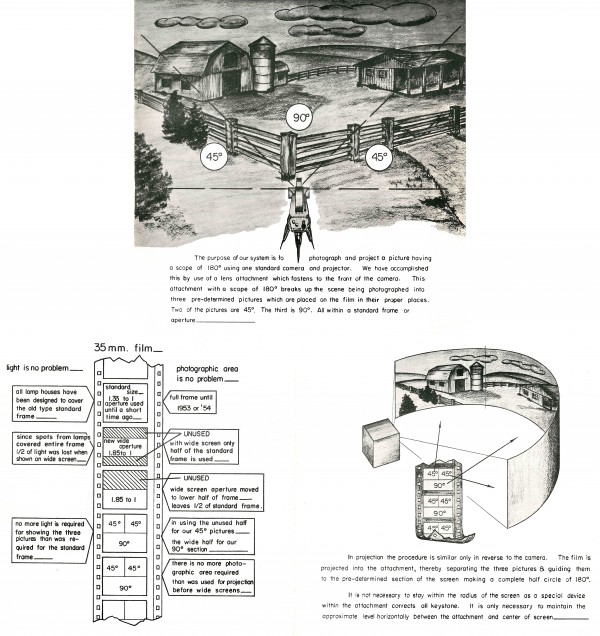
Pages from a promotional pamphlet, illustrating the mechanics of the Rotoscope technology, c. 1960s.
Rotoscope Collection (R1499), The State Historical Society of Missouri, Rolla, MO, United States.
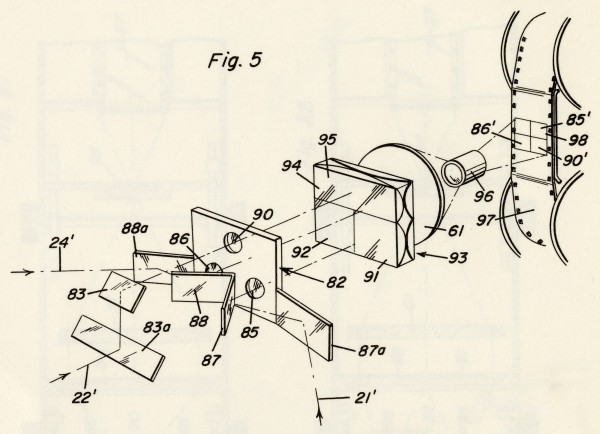
A schematic for the camera attachment.
Smith, Tom F. Motion picture camera for making panoramic pictures. US patent US3,055,265, filed September 18, 1959, and issued September 25, 1962.
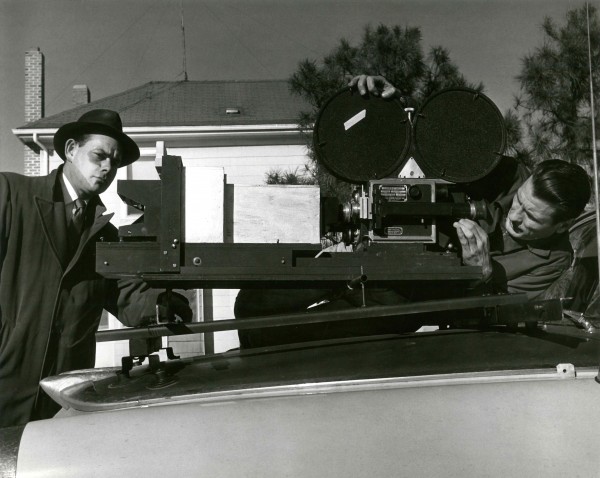
Rowe Carney (left) and Tom Smith (right) examining the latest camera attachment prototype, using a Mitchell NC camera. This particular version could be attached to the hood of a car, as seen in the photograph.
Rotoscope Collection (R1499), The State Historical Society of Missouri, Rolla, MO, United States.
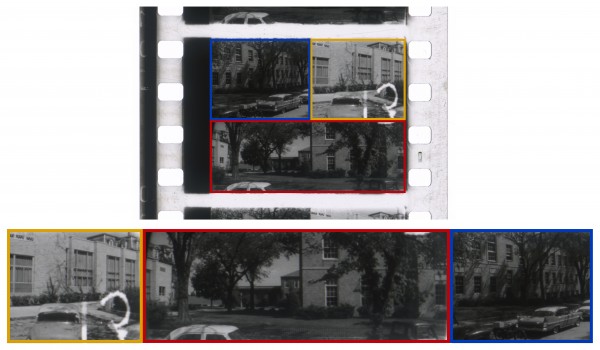
How a continuous 180-degree panoramic image was captured as three separate images on one standard 35mm film frame. This example was photographed on the campus of the Missouri School of Mines and Metallurgy (now Missouri University of Science and Technology), 1961.
Rotoscope Collection (R1499), The State Historical Society of Missouri, Rolla, MO, United States. Diagram by Crystal Kui.
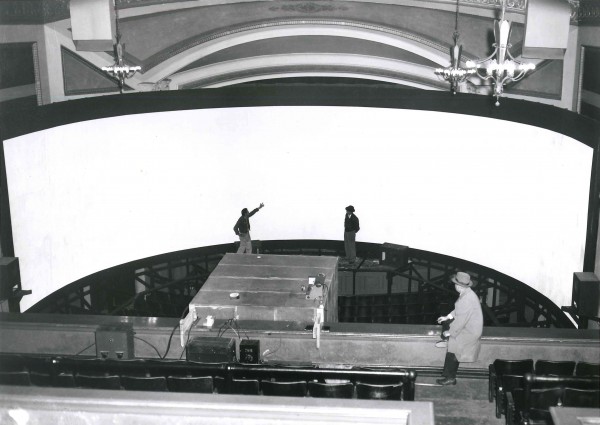
The 180-degree Rotoscope screen set up inside the Rollamo Theatre, Rolla, Missouri, in anticipation of the premiere of the demonstration film in 1961.
Rotoscope Collection (R1499), The State Historical Society of Missouri, Rolla, MO, United States.
References
Carney, Gene (2018). Interview by Sean Rost. Interview transcript, Missouri Innovation and Exploration Oral History Project Records (C4352), The State Historical Society of Missouri, Columbia, MO.
Hart, Martin (n.d.). “Smith-Carney System”. The American WideScreen Museum. http://www.widescreenmuseum.com/widescreen/smith-carney.htm
Index, The (1954). “New Autoscope Theatre Opens at Buffalo”. The Index (12 August). https://www.newspapers.com/image/113192345 (accessed October 1, 2024 [paywall])
Looney, Ralph. “Unique Drive-In Theater Here Tests Appeal of Small Screen,” The Albuquerque Tribune, July 6, 1963. https://www.newspapers.com/image/783156503
State Historical Society of Missouri (n.d.). “Rotoscope Collection (R1499)”. The State Historical Society of Missouri – Rolla Research Center, Missouri University of Science and Technology, Rolla, MO.
Patents
Smith, Tom F. Curved projection screen. US patent US3026770, filed April 2, 1958, and issued March 27, 1962. https://patents.google.com/patent/US3026770A/en?oq=3026770
Smith, Tom F. Motion picture camera for making panoramic pictures. US patent US3055265, filed September 18, 1959, and issued September 25, 1962. https://patents.google.com/patent/US3055265A/en?oq=3055265
Smith, Tom F. Panoramic projection system. US patent US3063334, filed March 25, 1958, and issued November 13, 1962. https://patents.google.com/patent/US3063334A/en?oq=3063334
Compare
Related entries
Author
Kathleen Seale is the coordinator for the Rolla and Springfield Research Centers of the State Historical Society of Missouri. She began working for the Society in 2016 as an archivist. She has bachelor’s degrees in history and anthropology from Missouri State University and a master’s in history with an emphasis in public history from Oklahoma State University. Seale worked with the Carney family to facilitate the donation of the Rotoscope Collection and completed the grant project through the National Film Preservation Foundation to digitize and create film copies of for reels of the Rotoscope film.
A huge thank you to Andy Uhrich for bringing this project to light and for offering your invaluable expertise in completing this entry. Special thanks also to Jeff Blyth for his digital recreation of 180-degree Rotoscope projection.
Seale, Kathleen (2024). “Rotoscope”. In James Layton (ed.), Film Atlas. www.filmatlas.com. Brussels: International Federation of Film Archives / Rochester, NY: George Eastman Museum.


